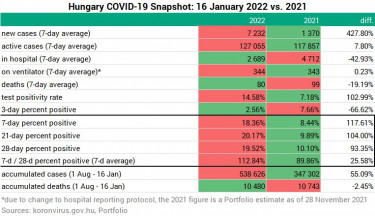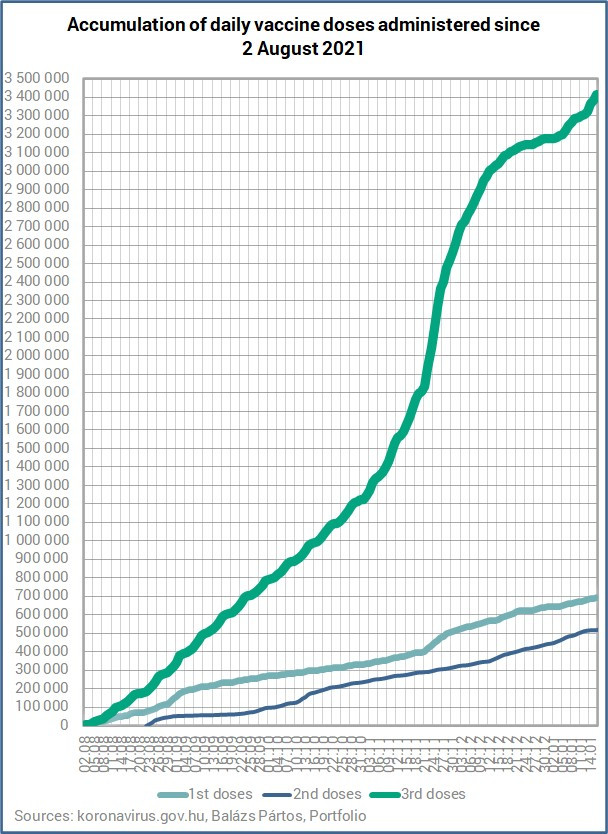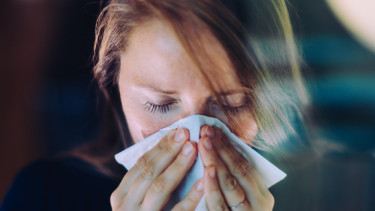COVID-19: New cases up 45%, deaths +62% over the weekend in Hungary


A year ago, the longer-term percent positive averages were all subsiding, while this year the Omicron variant has made sure the fifth wave in the coronavirus pandemic starts before the fourth wave is over. It is spreading extremely fast, doubling the number of cases every two days.

As the erratic testing practices have rendered the daily and even the short-term average positivity rates practically useless, we need to use longer-term averages to see where the pandemic is headed.

Here's our 'new' indicator, the 7-d / 28-day average and its 7-day average, for two periods: starting from 1 October 2021 and starting from 1 September 2020. Both are at their mid-Nov levels.


Looking back almost until the outbreak in 2020 we find that the 7-day average has not been this high since the end of November 2020.

The 7-day rolling average of new COVID-19 keeps on rising, and the number of Covid deaths is likely to follow suit, unless the Omicron variant causes less severe disease than Delta. While this may be true on average, experts of the World Health Organisation (WHO) warned against taking Omicron lightly.
Maria Van Kerkhove, the WHO’s Covid-19 technical lead, warned last week that "it is not just a mild disease", stressing that "this is really important because people are still being hospitalized for Omicron."
Dr. Mike Ryan, director of the WHO’s health emergencies program, said last Wednesday that Omicron represents a “massive threat” to the lives of the unvaccinated.

As you can see on the right-hand graph above and the one below, the 7-day average of Covid deaths has also started to rise, which is not really a surprise in light of the sharply rising number of new cases.

How's the situation in hospitals?
The number of Covid patients in hospital is largely unchanged from Friday, but shows a 10% drop week on week, and there are also fewer patients on ventilator (-19% w/w). As a result of this, the On ventilator / In hospital ratio has dropped further.


On the charts below the 0% line is important. When the curves are under 0% there’s a decline, when they go over 0% it’s an increase.
More importantly, when a value is north of 0% but the curve descends, it means an increase at a slowing rate, rather than a decrease. If the curve is above 0% and ascending, it is an increase at an accelerating rate. When we are under 0% and the curve goes lower, it translates into an accelerating decrease, and when it goes up it marks a decelerating decrease. As you can see, we are witnessing the latter here, and there was a turnaround in the improvement around 27-29 December. The number of active cases started to go up at an increasing rate at that time and the pace has only picked up. The changes in terms of hospitalisations and mechanical ventilation have been showing a similar start but then a different and mixed pattern. We need data for a couple of more days to see if the trend is changing for the worse or not, but an improvement would be surprising.

What do the changes mean?
The chart below shows the number of hospitalised Covid patients as a percentage of active cases and the On ventilator / In hospital ratio.
When a pandemic 'wave' starts, the percentage of hospitalised patients relative to active cases always soars, because there is still a relatively low number of official cases due to inferior testing practices, and because early on most people with positive tests are likely in hospital.
The green curve peaks around 7% in every 'wave' and then the ratio starts to drop as authorities 'find' more and more infections. The reason why this curve starts to descend even though the number of hospitalisations goes up drastically is because the increase in new confirmed COVID-19 cases is even more staggering.
When there's a relative calm, the red curve picks up sharply, because only those Covid patients are left in hospital that are in severe condition. The others either recovered and were discharged or died.
Early in these waves this ratio always rises rapidly (low number of tests, many in severe condition in hospital, a lot of them in ICUs), but then the ratio starts to improve.
There was an anomaly here, namely that this trend was broken in late November 2021. The proportion of those in hospital to active cases starts to drop, but the proportion of Covid patients in intensive care (relative to those in hospital) goes up. This indicates that there are too few people in hospital compared to before, i.e. there are more serious cases. As it is not the course of the disease that has become more severe, this indicates insufficient hospitalisation. As the number of active cases is on the rise, while the number of Covid patients in hospital is still dropping, the In hospital / Active cases ratio keeps on falling, and so does the On ventilator / In hospital. The latter has been hovering around 13.3-13.4% for more than two weeks but it dropped to 12.4% by now from 13.1% only four days ago.

While about one third of the population (3.4 mn people) are inoculated with three doses of COVID-19 vaccines, about 3.5 million people have not received a single shot yet. Also, as the effectiveness of vaccines wanes over time, about three million Hungarians have diminished or no protection against coronavirus infection, even after two jabs.
The cabinet has announced a new vaccination campaign for January where Hungarians may, after on-site registration, ask for their first, second or third dose of a COVID-19 vaccine. The shots will be administered at vaccination locations between 2 and 6 p.m. on Thursdays and Fridays and between 10 a.m. and 6 p.m. on Saturdays.
Hungary is to make a fourth COVID-19 shot available to people who ask for it, after a consultation with a doctor, Prime Minister Viktor Orbán's chief of staff, Gergely Gulyás, told a news conference on Thursday.
Minister of Human Capacities Miklós Kásler said on Monday a fourth dose is recommended for those over 60 years of age that have an underlying disease, such as hypertension or diabetes, as well as for immunodeficiency conditions, for example after chemotherapy for malignant tumours, and after transplantation for all immunodeficiency conditions.



Cover photo: Portfolio









